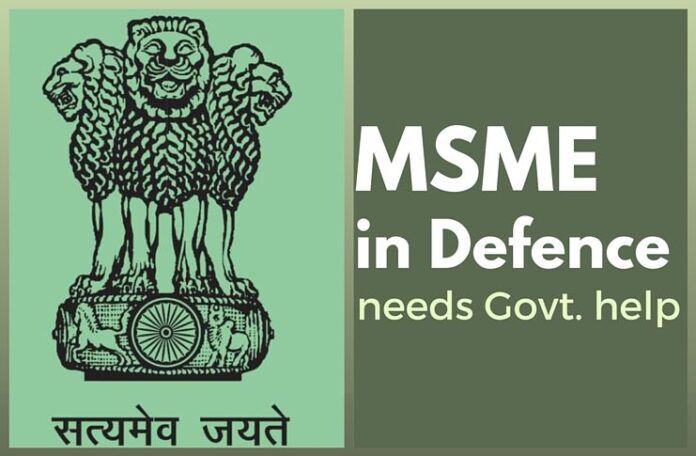
[dropcap color=”#008040″ boxed=”yes” boxed_radius=”8px” class=”” id=””]S[/dropcap]mall and Meduim enterprises (SME) forms the back bone of any nation’s industrial capability. Indian defence manufacturing sector is not immune to this fact. The defence public sector undertakings (DPSU) and ordinance factory board (OFB) along with DRDO employs hundreds of SME in t supply chain. If nation wants to be self reliant in defence manufacturing then government will have to nurture SMEs in this sector.
As per the Annual Report of Ministry of MSME for the year 2013-14, there are 4.88 cr MSME units in India employing more than 11 cr people and has fixed assets worth 1.36 lakh crores. This sector is contributing around 37 percent of Industrial output and contributing 37 percent to national GDP.
In last two years government has taken steps towards bringing the SMEs closer to the user, ie armed forces as well as has made efforts in bringing the SMEs closer to each other for better synergy among the industry. Ministry of MSME organised an International Sub-contracting and Supply chain exhibition on Defence, Aerospace and Homeland Security in December, 2013 at Bangalore. The event was supported by Ministry of Defence (GOI), Ministry of MSMEs (GOI), Indian Air Force and Government of Karnataka. The event was organized to provide platform for companies to promote their products and services to domestic and international companies of Defence, Aerospace and Homeland Security sector. More than 200 MSMEs participating as exhibitors and 500 plus B2B meetings were scheduled in the event.
Ministry of MSME, further organised Vendor Development Programme with Indian Air force in Coimbatore in January next year to provide opportunity to venders to have firsthand interaction with the defence products purchasing officials.
[dropcap color=”#008040″ boxed=”yes” boxed_radius=”8px” class=”” id=””]G[/dropcap]overnment has realized the importance of the SMEs in the defence manufacturing and has been taking concerted policy steps to create space for them in defence sector. The defence procurement policy (DPP) encourages participation of private industries in Defense Production. The ‘Make’ procedure of DPP is for design, research, development and production of indigenous defence equipment by Indian industry. The biggest beneficiary of this policy is the SME sector. In the same line the defence offset policy would be benefitting the SMEs big time. The initial offset will be for the smaller off the shelf component which are manufactured by smaller industries only.
According to CII report on enhancing the role of SME in Indian defence industry, the global defence industry which is primarily dominated by a few Original Equipment Manufacturers (OEMs), works similarly in close co-ordination with SMEs and their prime contractors through a well defined supply chain. The reason why OEMs / prime contractors prefer to work with SMEs is because of their innovative capabilities in niche manufacturing, greater flexibility, lower overhead costs and their ability to learn and absorb new technologies.
CII Report further suggests that the OEMs require that the SMEs they work with should have the ability to perform, maintain continuity of supplies and clearly understand how the defence procurement procedure works. Hence, to be able to integrate successfully in the value chain, SMEs must try to develop niche products and capabilities, continuously innovate and fully leverage export opportunities that are now available to them under the Defence offset policy.
[dropcap color=”#008040″ boxed=”yes” boxed_radius=”8px” class=”” id=””]T[/dropcap]o rise upto the expectations this sector is facing a few challenges. Foremost is the prohibitive cost of R&D for development of cutting edge technologies. Globally the major part of product development takes place at the third tier of the supply chain populated by this sector, those innovations may not always be the cutting edge in terms of technological breakthrough yet are very significant for product’s superiority and the financial investment that goes into these is very significant in terms of the small firms turnover. Unless there is an assurance of orders no SME can invest such money. And in India the defence majors and development agencies are non cooperative in sharing the technical knowhow which further restricts the technological upgrade of SMEs in this sector.
SMEs need to tackle the challenges of human resource like finding and retaining talent, sourcing specialized skills and providing training in futuristic technology to its employees. All of these are possible when there is a long term industrial road map is available with sector for defence industry. Industries should know what are the products that government intent to purchase in next 10-15 years and what components would be procured from SMEs. Then only SMEs would be in position to plan a long term strategy for themselves. This will help them in selecting a niche area for themselves and they can invest in the technology and human resources keeping the long term strategy in mind. All of this is not possible until the Government shoulders some responsibility and begins to support R&D activity for SMEs through a dedicated fund. An annual fund of minimum 1000 cr should be earmarked for research support to SMEs.
- An interview withLt Gen Narsimhan - July 17, 2017
- Nation can’t pay for Mamata’s short sighted politics - July 8, 2017
- Time for New Approach to Afghanistan - June 14, 2017










